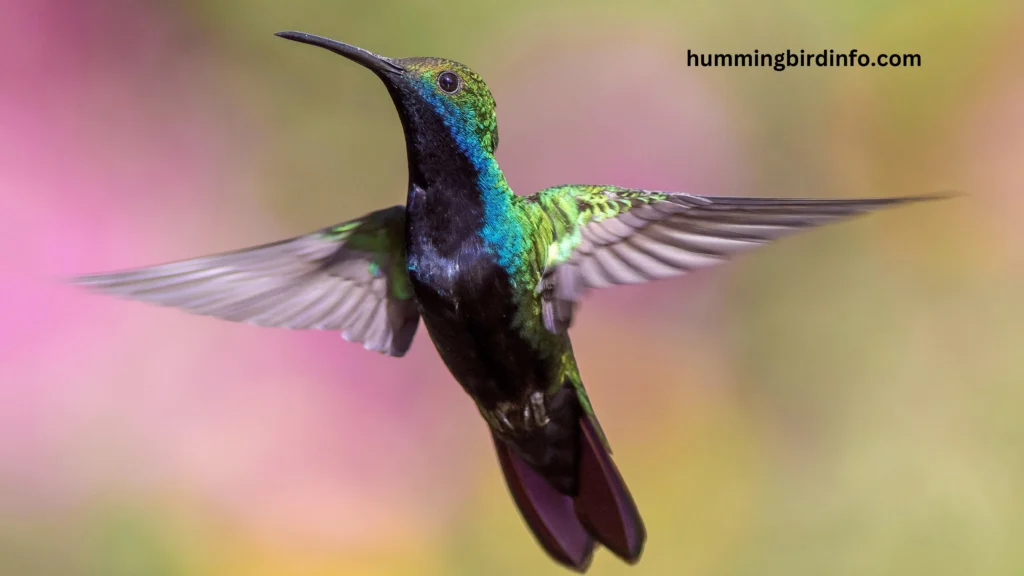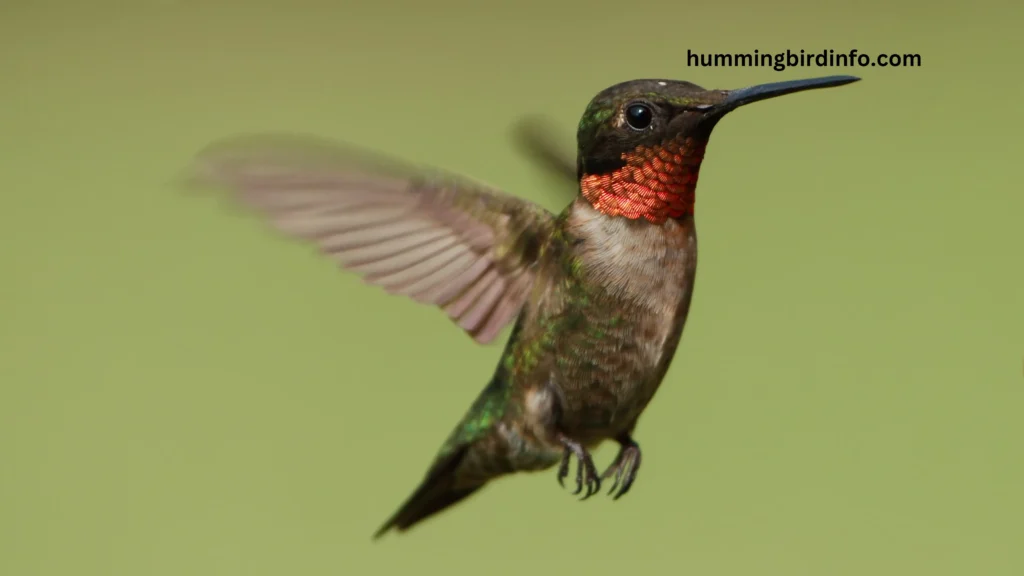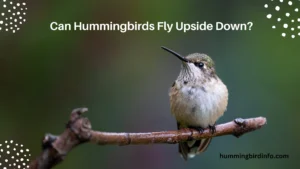Hummingbirds, with their tiny frames and dazzling wings, are some of the most captivating creatures on Earth. Their ability to hover in mid-air, dart between flowers, and perform acrobatic feats is nothing short of awe-inspiring.
Unlike any other bird, hummingbirds possess the extraordinary ability to fly backward, upside down, and even remain stationary for long periods. This ability isn’t just impressive; it’s a feat of evolutionary design, years of specialized adaptation, and unparalleled aerodynamics.
Why should you care about hummingbird flight? Beyond the beauty and wonder of these creatures, understanding how they achieve such incredible flight could unlock technological advancements in fields like robotics, engineering, and aviation.
These tiny aviators hold the keys to mastering agility, speed, and flight dynamics—something researchers and engineers are eager to learn from.
In this post, we will delve deep into the mechanics behind their flying skills, uncovering the anatomy, physics, and evolutionary marvels that allow hummingbirds to fly like no other species. You’ll come away with a new appreciation for how these small birds manage to do what seems impossible.
Contents
- 1 Anatomy of Flight: Wings, Muscles, and Skeleton
- 2 The Mechanics of Hovering: A Delicate Balance
- 3 Beyond Hovering: Forward, Backward, and Acrobatic Flight
- 4 High Energy Demands: Fueling the Flight
- 5 Evolutionary Adaptations for Flight
- 6 Conclusion:
- 7 FAQs
- 8 How do hummingbirds hover?
- 9 Why are hummingbirds the only birds that can fly backward?
- 10 What is the role of a hummingbird’s large pectoral muscles?
- 11 How fast do hummingbirds fly?
- 12 What fuels a hummingbird’s flight?
- 13 Can hummingbirds fly upside down?
Anatomy of Flight: Wings, Muscles, and Skeleton
To understand how hummingbirds achieve their incredible flight, we first need to look at their specialized anatomy.
Specialized Wings:
Hummingbird wings are long, narrow, and relatively straight, unlike the curved wings of other birds. Their wing structure allows them to rotate their wings nearly 180 degrees at the shoulder joint, giving them a high degree of maneuverability.
Powerful Muscles:
The pectoral muscles of hummingbirds are exceptionally large, accounting for a significant portion of their body mass. These muscles generate the rapid, powerful wingbeats necessary for flight. The muscles that control both the downstroke and upstroke work in harmony to produce the needed lift and thrust.

Skeletal Adaptations:
Hummingbirds have a reinforced ribcage and a large sternum (breastbone) to anchor their flight muscles. Their skeletal structure is also designed for flexibility, particularly at the ball-and-socket joint where the wing meets the shoulder, allowing for near full rotation.
Feather Structure:
The feathers of hummingbirds are adapted to provide efficient airflow and lift. The primary and secondary feathers play a critical role in generating lift, while contour feathers help maintain the bird’s aerodynamic shape.
Wingbeat Frequency:
Hummingbirds beat their wings at an incredibly high frequency—up to 1,200 beats per minute. This rapid motion is crucial for their ability to hover, fly backward, and perform intricate aerial maneuvers.
The Mechanics of Hovering: A Delicate Balance
Hovering is perhaps the most distinctive trait of a hummingbird’s flight. To stay in one place, hummingbirds must generate enough lift to counterbalance their body weight.
Figure-Eight Wing Motion:
Unlike most birds, hummingbirds generate lift on both their downstroke and upstroke. The unique figure-eight motion of their wings allows them to produce lift continuously while maintaining a stationary position.
Lift Generation on Both Strokes:
Hummingbirds are capable of creating lift during both the downstroke and the upstroke, a mechanism that sets them apart from most other birds, which only generate lift on the downstroke. This is made possible through Bernoulli’s principle and Newton’s third law, which govern the physics of aerodynamics.
Leading-Edge Vortices:
As the wings rotate rapidly, they create leading-edge vortices (LEV), which enhance lift and provide extra stability during hovering. These vortices are critical for maintaining their position in the air without losing altitude.
Airflow Patterns:
The airflow around a hummingbird’s wings is incredibly complex, involving turbulent flow and the formation of vortices. The bird’s ability to control these airflow patterns allows for precise adjustments in flight.
Precise Control:
Hummingbirds have exceptional control over their wing movements, allowing them to make fine adjustments to their position and stability while hovering. This precision is key to their ability to feed while flying and navigate through tight spaces.
Beyond Hovering: Forward, Backward, and Acrobatic Flight
While hovering is a remarkable skill, hummingbirds are also capable of highly maneuverable and dynamic flight.
Forward Flight:
To achieve forward flight, hummingbirds tilt their bodies slightly and adjust the angle of their wing strokes. This tilt generates thrust in addition to lift, propelling them forward.
Backward Flight:
Hummingbirds are the only birds that can fly backward. By reversing the angle of their wing strokes, they can easily retreat from flowers, navigate tight spaces, and avoid predators.
Maneuverability:
Hummingbirds can rapidly change direction, accelerate, decelerate, and even perform upside-down maneuvers. This agility is crucial for their survival, especially in complex environments like flower-filled forests.
Courtship Displays:
In courtship, male hummingbirds perform dramatic aerial displays, including high-speed dives and acrobatic stunts, to demonstrate their agility and fitness to potential mates.
Flight Through Obstacles:
Hummingbirds can fly through narrow gaps and spaces by tucking their wings and using sideways maneuvers, a skill that is vital when navigating crowded environments.
High Energy Demands: Fueling the Flight
The energy demands of hummingbird flight are immense, as these birds need to sustain rapid wingbeats and an elevated metabolism.
High Metabolism:
Hummingbirds have a high metabolic rate, which allows them to generate the energy required for their rapid wingbeats. Their heart rate can soar to over 1,200 beats per minute during flight.
Nectar as Fuel:
Hummingbirds primarily rely on nectar for energy, converting the sugars into fuel almost immediately. Their specialized tongues allow them to extract nectar efficiently from flowers.
Feeding Strategies:
Hummingbirds feed frequently, consuming up to twice their body weight in nectar daily. They also eat insects to meet their protein needs, further supporting their energy demands.

Torpor:
When food is scarce, some species enter torpor, a hibernation-like state that allows them to conserve energy by lowering their body temperature and metabolic rate.
Efficient Digestion:
The hummingbird’s digestive system is adapted to quickly convert food into fuel, ensuring they have a continuous supply of energy for flight. This allows them to maintain their agility throughout the day.
Evolutionary Adaptations for Flight
Hummingbirds’ incredible flight abilities have evolved over millions of years, allowing them to exploit resources like nectar and thrive in their environment.
Evolutionary History:
Hummingbirds evolved from insect-eating ancestors, adapting specialized flight mechanics to feed while flying. Their ability to hover evolved as a response to the need to feed on nectar without landing.
Co-evolution with Flowers:
There has been a co-evolutionary relationship between hummingbirds and flowering plants. Over time, flowers have evolved shapes and colors that attract hummingbirds, while hummingbirds have developed flight abilities to access nectar from specific flowers.
Adaptations for Hovering:
The ability to hover is a key evolutionary adaptation that allows hummingbirds to feed without needing to land, giving them a competitive edge in environments rich with nectar-producing plants.
Survival of the Fittest:
The hummingbird’s ability to hover and perform acrobatics plays a critical role in its survival, helping it to access food sources and avoid predators more effectively than other birds.
Flight as an Evolutionary Necessity:
As a result of these adaptations, hummingbirds have become masters of flight, capable of surviving and thriving in environments where other birds cannot.
Conclusion:
Hummingbird flight is nothing short of a marvel of nature, combining agility, precision, and efficiency in ways that no other creature can match. From hovering effortlessly in mid-air to performing incredible acrobatics, these tiny aviators have perfected the art of flight through millions of years of evolution.
Their unique anatomy, extraordinary muscle power, and aerodynamic mechanics have made them masters of the sky. This not only allows them to feed and mate with unmatched skill but also to evade predators and navigate complex environments with ease.
The hummingbird’s flight mechanics serve as a model for understanding not only the wonders of the natural world but also the potential applications of bio-inspired design. Researchers and engineers are already looking to these incredible flyers for insights that could lead to more agile drones, better aerial robotics, and even advancements in medical devices.
In every flap of their wings, hummingbirds show us the beauty of nature’s design and its potential to revolutionize technology.
By studying these awe-inspiring creatures, we gain a deeper appreciation for the intricacies of flight and the incredible adaptations that allow hummingbirds to thrive in the air. Their flight is not just an act of survival—it’s a perfect blend of nature’s genius and evolutionary perfection.
FAQs
How do hummingbirds hover?
Hummingbirds hover by using a unique figure-eight motion of their wings, which allows them to generate lift on both the downstroke and upstroke. This gives them the stability required to remain stationary in the air.
Why are hummingbirds the only birds that can fly backward?
Hummingbirds can fly backward due to the ability to reverse the angle of their wing strokes. This motion allows them to retreat from flowers or evade predators with ease.
What is the role of a hummingbird’s large pectoral muscles?
The large pectoral muscles of a hummingbird provide the power for rapid wingbeats. These muscles account for a significant portion of their body mass, enabling the bird to perform such fast and intricate flight patterns.
How fast do hummingbirds fly?
Hummingbirds can reach speeds of up to 30 miles per hour during forward flight, but their most impressive ability is the speed of their wingbeats, which can exceed 720 to 1,200 beats per minute.
What fuels a hummingbird’s flight?
Nectar, a sugar-rich food source, fuels a hummingbird’s flight, providing the quick energy needed for their high metabolism and rapid wing movements. They also eat insects for protein.
Can hummingbirds fly upside down?
Yes, hummingbirds can fly upside down thanks to their highly flexible wing movement and ability to adjust the angle of their wings in all directions. This is a part of their exceptional maneuverability.








